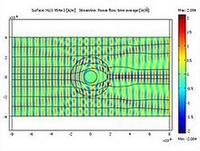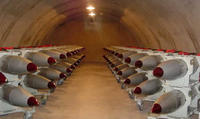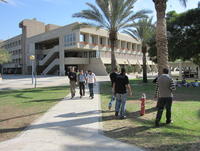-
Funding extended for simulated nuclear reactor project
Hard on the heels of a five-year funding renewal, modeling, and simulation (M&S) technology developed at Los Alamos National Laboratory as part of the Consortium for the Advanced Simulation of Light Water Reactors (CASL) will now be deployed to industry and academia under a new inter-institutional agreement for intellectual property. CASL is a U.S. Department of Energy’s Energy Innovation Hub established in 2010 to develop advanced M&S capabilities that serve as a virtual version of existing, operating nuclear reactors. As announced by DOE in January, the hub would receive up to $121.5 million over five years, subject to congressional appropriations.
-
-
DNA synthesis creates risk of resurrecting deadly viruses
Scientists are warning that decades of public research on the sequencing of virus DNA are now posing unforeseen threats, as synthesis technologies advance to the point where individuals without expert knowledge may be able to reconstruct long dormant viruses using readily available maps. Diseases which have been extinct for many years may be resurrected by bioterrorists using mail-order DNA kits, with openly published sequence data as their guide. Among these, smallpox eradicated since 1980, could be reintroduced by using the 1994 gene mapping which was prepared in order better to understand why the disease was so deadly.
-
-
Throwing science at anti-vaxxers just makes them more hardline
Since the uptick in outbreaks of measles in the United States, those arguing for the right not to vaccinate their children have come under increasing scrutiny. What drives anti-vaxxers is similar to what drives other groups – climate skeptics, for example – which also hold beliefs at odds with conventional scientific thought: It is a process psychologists have called “biased assimilation” — we all regard new information in the light of what we already believe. Research shows that throwing scientific facts at anti-vaxxers is not likely to change minds because the level of knowledge and expertise of the people providing the facts — government, scientists, or journalists, say — was a poor predictor of how much they were trusted on the issue. Instead, what was critical was how much these experts were perceived to have the public’s interests at heart. Researchers who conducted surveys on the issue of pollution, for example, found that groups of people — such as friends and family — who were perceived to want to act in line with the survey respondents’ best interests were highly trusted, even if their expertise on the issue was judged as poor. Rather than lacking scientific facts, anti-vaxxers lack a trust in the establishments which produce and disseminate science.
-
-
Invisibility cloak closer to reality: Concealing military airplanes, and even people

Since the beginning of recorded time, humans have used materials found in nature to improve their lot. Since the turn of this century, scientists have studied metamaterials, artificial materials engineered to bend electromagnetic, acoustic, and other types of waves in ways not possible in nature. Now, Hao Xin, a professor of electrical and computer engineering at the University of Arizona, has made a discovery with these synthetic materials that may take engineers one step closer to building microscopes with superlenses that see molecular-level details, or shields that conceal military airplanes and even people.
-
-
U Wisconsin, shedding 1960s anti-classified research image, launches cybersecurity center
A new cybersecurity research center being built in partnership with private firms and the University of Wisconsin(UW) system aims to attract high-tech research dollars to the state, but administrators must balance the secrecy required for classified research with the openness which is the foundation of academic science. The state legislature passed a 2014 law allowing UW to accept contract for classified work partly in hopes that the school system will lose the perception of being an anti-classified-research environment, a perception dating back to campus protests against military research in the 1960s.
-
-
Research advocates urge 114th Congress to act on Top 5 science priorities in first 100 days
Research!America urged the 114th Congress to take action on five science priorities in the first 100 days of the legislative session in order to elevate research and innovation on the U.S. agenda. The organizations says that the five priorities: end sequestration, increase funding for U.S. research agencies, advance the 21st Century Cures initiative, repeal the medical device tax, and enact a permanent and enhanced R&D tax credit.
-
-
Young researchers increasingly denied research grants, putting the future of U.S. science at risk
America’s youngest scientists, increasingly losing research dollars, are leaving the academic biomedical workforce, a brain drain that poses grave risks for the future of science, according to an article published this week by Johns Hopkins University president Ronald J. Daniels. For example, the number of principal investigators with a leading National Institutes of Health grant who are 36 years old or younger dropped from 18 percent in 1983 to 3 percent in 2010. Meanwhile, the average age when a scientist with a medical degree gets her first of these grants has risen from just under 38 years old in 1980 to more than 45 in 2013.
-
-
U.S. nuclear arsenal must be upgraded to maintain effective deterrence: Experts

Former military officers, academic strategists, scientists, and congressional leaders have recently been calling for the development of new nuclear weapons to replace the nation’s older, outdated stockpiles. Twenty-five years since the cold war ended, the U.S. nuclear arsenal has been significantly reduced to its current level of 4,804 nuclear weapons — from a peak of 31,000 weapons in 1967.As cooperation with Russia deepened in the 1990s, U.S. weapons complexes deteriorated. A recent “60 Minutes” story on the U.S. nuclear forces found that missileers charged with watching over and controlling Minuteman III ICBMs in Wyoming were still using floppy disks to store critical information. One expert arguing for shoring up and upgrading the U.S. nuclear deterrence says that “one of the reasons deterrence is so valuable is that it provides incentives for self-discipline in the behavior of states that otherwise cannot be trusted to behave peaceably.”
-
-
Transforming planes into flying aircraft carriers
Military air operations typically rely on large, manned, robust aircraft, but such missions put these expensive assets — and their pilots — at risk. While small unmanned aircraft systems (UAS) can reduce or eliminate such risks, they lack the speed, range, and endurance of larger aircraft. These complementary traits suggest potential benefits in a blended approach — one in which larger aircraft would carry, launch, and recover multiple small UAS. A flying carrier would allow the United States to use of drones in areas where the United States has no access to nearby airfields, but recovering a drone in mid-air remains a daunting technical challenge.
-
-
U.S. seeking innovative solutions for protecting healthcare workers on Ebola front lines
The U.S. Agency for International Development (USAID) has issued a Broad Agency Announcement (BAA), saying the agency is looking for opportunities to co-create, co-design, co-invest, and otherwise collaborate in the development, testing, and scaling of practical and cost-effective innovations to help healthcare workers on the front lines provide better care and stop the spread of Ebola. USAID notes that this funding mechanism will not support research that does not provide a clear path to development and testing of prevention and intervention strategies. Awards are in the range of $100,000 to $1million.
-
-
New tool can be used as a universal Ebola drug target

University of Utah biochemists have reported a new drug discovery tool against the Ebola virus. According to a study published in this week’s online edition of Protein Science, they have produced a molecule, known as a peptide mimic, which displays a functionally critical region of the virus that is universally conserved in all known species of Ebola. This new tool can be used as a drug target in the discovery of anti-Ebola agents which are effective against all known strains and likely future strains. The same group of biochemists has previously developed highly potent and broadly acting D-peptide inhibitors of HIV entry, currently in preclinical studies, and is now adapting this approach to Ebola using the mimics developed in this study.
-
-
More research needed to address synthetic biology security concerns
Synthetic biology involves the design of new biological components, devices, or systems that do not exist in nature, or the redesign of existing natural biological systems. Synthetic biology aims to make biological systems work more efficiently or to design biological tools for specific applications — such as developing more effective antibiotics. A new paper examines security risks and policy questions related to the growing field of synthetic biology. While the author does not think the field is ripe for exploitation by terrorists, it does highlight significant gaps in our understanding of the nuts and bolts of lab work in synthetic biology that can contribute to security risks.
-
-
R&D at DHS is “inherently fragmented”: GAO
The GAO says that DHS does not know how much it spends on R&D, making it difficult for the sprawling agency to oversee and coordinate those efforts. David Maurer, GAO’s director of Homeland Security and Justice, told a House hearing that R&D at DHS is “inherently fragmented.” The reason is that each of several components of the agency — the Science and Technology Directorate, the Coast Guard, and the Domestic Nuclear Detection Office — are given R&D responsibilities by law. At the same time, other DHS components conduct their own R&D efforts as long as those activities are coordinated through the S&T office, Maurer said.
-
-
$5 million for new cybersecurity building at Ben-Gurion University of the Negev

Ben-Gurion University of the Negev (BGU) is a central component of the new “CyberSpark” initiative, a multi-component cyber eco-system. It is the only complex of its type in the world which is a government-academic-industry partnership and includes Fortune 500 companies and cyber-incubators, academic researchers and educational facilities, as well as national government and security agencies. A $5 million contribution will underwrite construction of the building that will house the Cyber Security Institute.
-
-
NIH launching human safety study of Ebola vaccine candidate
The National Institute of Allergy and Infectious Diseases (NIAID), part of the National Institutes of Health (NIH), will this week begin initial human testing of an investigational vaccine to prevent Ebola virus disease. The early-stage trial will begin initial human testing of a vaccine co-developed by NIAID and GlaxoSmithKline (GSK) and will evaluate the experimental vaccine’s safety and ability to generate an immune system response in healthy adults. The study is the first of several Phase 1 clinical trials that will examine the investigational NIAID/GSK Ebola vaccine and an experimental Ebola vaccine developed by the Public Health Agency of Canada and licensed to NewLink Genetics Corp.
-
- All
- Regional
- Water
- Biometrics
- Borders/Immig
- Business
- Cybersecurity
- Detection
- Disasters
- Government
- Infrastructure
- International
- Public health
- Public Safety
- Communication interoperabillity
- Emergency services
- Emergency medical services
- Fire
- First response
- IEDs
- Law Enforcement
- Law Enforcement Technology
- Military technology
- Nonlethal weapons
- Nuclear weapons
- Personal protection equipment
- Police
- Notification /alert systems
- Situational awareness
- Weapons systems
- Sci-Tech
- Sector Reports
- Surveillance
- Transportation
Advertising & Marketing: advertise@newswirepubs.com
Editorial: editor@newswirepubs.com
General: info@newswirepubs.com
2010-2011 © News Wire Publications, LLC News Wire Publications, LLC
220 Old Country Road | Suite 200 | Mineola | New York | 11501
Permissions and Policies
Editorial: editor@newswirepubs.com
General: info@newswirepubs.com
2010-2011 © News Wire Publications, LLC News Wire Publications, LLC
220 Old Country Road | Suite 200 | Mineola | New York | 11501
Permissions and Policies
